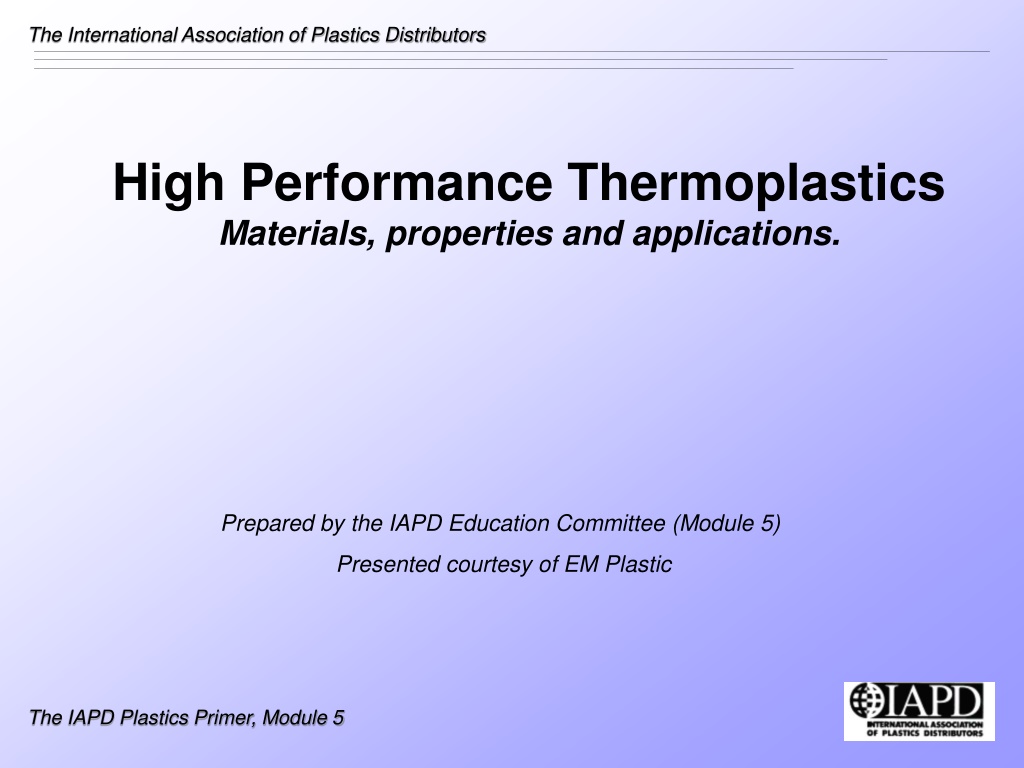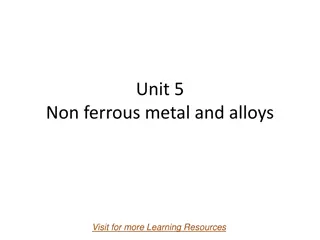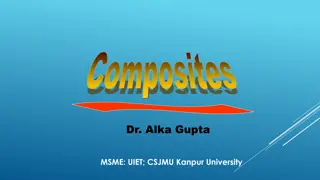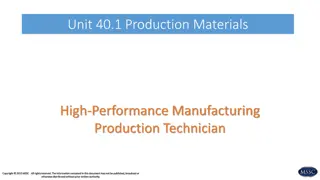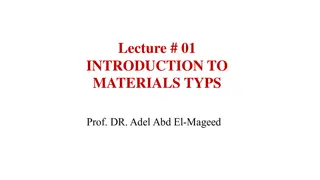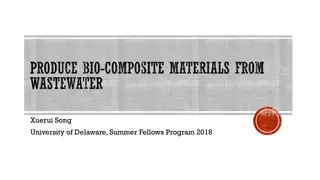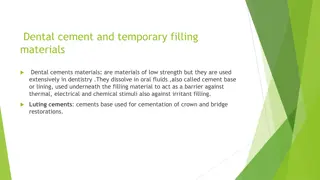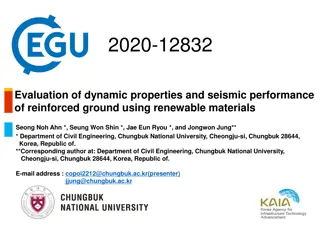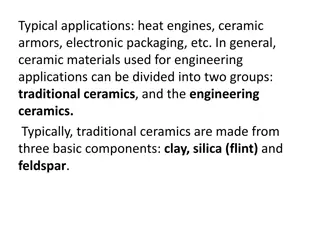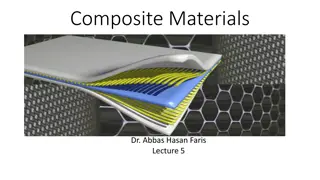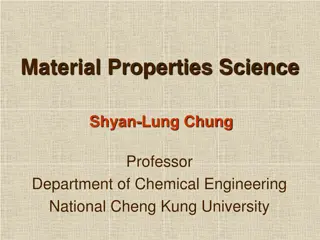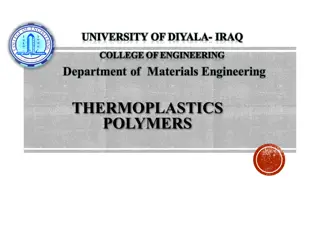Understanding High Performance Thermoplastics: Materials, Properties, and Applications
Explore the various types of high-performance thermoplastics, including their key characteristics and applications. From semi-crystalline to amorphous plastics, learn about their costs, strengths, electrical properties, chemical resistance, and more. Discover the differences between amorphous and semi-crystalline plastics, their melting points, thermoforming abilities, transparency, and bonding characteristics. Gain insights into choosing the right thermoplastic for your specific needs based on properties like temperature resistance, strength, and cost.
Download Presentation

Please find below an Image/Link to download the presentation.
The content on the website is provided AS IS for your information and personal use only. It may not be sold, licensed, or shared on other websites without obtaining consent from the author. Download presentation by click this link. If you encounter any issues during the download, it is possible that the publisher has removed the file from their server.
E N D
Presentation Transcript
The International Association of Plastics Distributors High Performance Thermoplastics Materials, properties and applications. Prepared by the IAPD Education Committee (Module 5) Presented courtesy of EM Plastic The IAPD Plastics Primer, Module 5
The International Association of Plastics Distributors IAPD THERMOPLASTICS RECTANGLE IMIDE MATERIALS Key Characteristics: Very High Cost Per Pound Excellent Properties Above 400 F Excellent Electrical Properties Excellent Dimensional Stability Low Coefficient of Friction Materials: PI PAI PBI SEMI-CRYSTALLINE HIGH PERFORMACE PLASTICS AMORPHOUS HIGH PERFORMANCE PLASTICS Key Characteristics High Cost High Temperature High Strength & Good Stiffness Good Chemical Resistance Transparency Hot Water & Steam Resistance Materials: Polysulfone Polyetherimide Polyethersulfone Polyarylsulfone Key Characteristics: High Cost High Temperature High Strength Good Electrical Properties Outstanding Chemical Resistance Low Coefficient of Friction Good Toughness SEMI-CRYSTALLINE ENGINEERING PLASTICS Materials: PVDF PTFE ECTFE FEP PFA PPS PEEK SEMI-CRYSTALLINE PLASTICS AMORPHOUS PLASTICS AMORPHOUS ENGINEERING PLASTICS Key Characteristics: Moderate Cost Moderate Temperature Resistance Moderate Strength Good Impact Resistance Translucency Good Dimensional Stability Good Optical Qualities Materials: Polycarbonate Modified PPO Modified PPE Thermoplastic Urethane Key Characteristics: Moderate Cost Moderate Temperature Resistance Moderate Strength Good Chemical Resistance Good Bearing and Wear Properties Low Coefficient of Friction Difficult to Bond Materials: Nylon Acetal PET PBT UHMW-PE AMORPHOUS COMMODITY PLASTICS SEMI-CRYSTALLINE COMMODITY PLASTICS Key Characteristics: Low Cost Low Temperature Resistance Low Strength Excellent Chemical Resistance Low Coefficient of Friction Near Zero Moisture Absorption Very Good Electrical Properties Good Toughness Key Characteristics: Low Cost Low Temperature Resistance] Low Strength Good Dimensional Stability Bond Well Typically Transparent Materials: Acrylic Polystyrene ABS PVC PETG CAB Materials: Polyethylene Polypropylene Polymetnylpentene(TPX) AMORPHOUS PLASTICS KEY CHARACTERISTICS: Soften Over a Broad Range Of Temperatures Easy to Thermoform Tend to Be Transparent Bond Well Using Adhesives and Solvents Prone To Stress Cracking Poor Fatigue Resistance Stuctural Applications Only (Not for Bearing & Wear) SEMI-CRYSTALLINE PLASTICS KEY CHARACTERISTICS: Sharp Melting Point Difficult to Thermoform Tend to Be Opaque Difficult To Bond Using Adhesives and Solvents Good Resistance To Stress Cracking Good Fatigue Resistance Good For Bearing and Wear, As Well As Structural Applications The IAPD Plastics Primer, Module 5
The International Association of Plastics Distributors Imidized Plastics Key Characteristics Very high cost per pound Excellent properties above 204 C/400 F Excellent electrical properties Excellent dimensional stability Low coefficient of friction (COF) The IAPD Plastics Primer, Module 5
The International Association of Plastics Distributors Imidized Plastics Materials Polyimide (PI) Polyamide Imide (PAI) Polybenzimidazole (PBI) The IAPD Plastics Primer, Module 5
The International Association of Plastics Distributors Polyimide (PI) Strengths Excellent high temperature mechanical performance Very high tensile and compressive strength Outstanding bearing and wear properties Very high purity Good chemical resistance The IAPD Plastics Primer, Module 5
The International Association of Plastics Distributors Polyimide (PI) Limitations Low physical properties Poor in high temp applications Cost The IAPD Plastics Primer, Module 5
The International Association of Plastics Distributors Polyimide (PI) Applications Aerospace Semiconductor Electrical/electronic Transportation Off highway equipment Pump and valve Hydraulics Automotive Textile Clean rooms The IAPD Plastics Primer, Module 5
The International Association of Plastics Distributors Polyamide-imide (PAI) Strengths Good stiffness and strength Good creep resistance Inherently flame retardant Good chemical resistance Good wear resistance Good friction properties Versatile The IAPD Plastics Primer, Module 5
The International Association of Plastics Distributors Polyamide-imide (PAI) Limitations Molding limitations High temperature limitations Post curing may be required Very high cost The IAPD Plastics Primer, Module 5
The International Association of Plastics Distributors Polyamide-imide (PAI) Applications Computer wafer handling units Bearings Compressor vanes Lantern rings Pump housings Hydraulic components Glass handling parts Seals High temperature electrical connectors Gears Semiconductor test sockets Insulators Transmission seal rings The IAPD Plastics Primer, Module 5
The International Association of Plastics Distributors Polybenzimidazole (PBI) Strengths Outstanding heat resistance and mechanical property retention at temperatures above 204 C /400 F Excellent wear resistance Excellent load bearing capabilities Low COF Clean The IAPD Plastics Primer, Module 5
The International Association of Plastics Distributors Polybenzimidazole (PBI) Limitations Not available as a resin Not processed by conventional techniques Not good in hot, aqueous solutions The IAPD Plastics Primer, Module 5
The International Association of Plastics Distributors Polybenzimidazole (PBI) Applications Protective clothing Aircraft furnishings Thermal insulators Electrical connectors Seals The IAPD Plastics Primer, Module 5
The International Association of Plastics Distributors Amorphous High Performance Thermoplastics Key Characteristics Thermal stability Cost effective high-performance materials Toughness High heat deflection temperatures Good chemical resistance Transparency Hot water and steam resistance Good radiation stability FDA compliant grades available The IAPD Plastics Primer, Module 5
The International Association of Plastics Distributors Amorphous High Performance Thermoplastics Materials Polysulfone (PSU) Polyetherimide (PEI) Polyether Sulfone (PES) Polyaryl Sulfone (PAS) The IAPD Plastics Primer, Module 5
The International Association of Plastics Distributors Polysulfone (PSU) Key Characteristics Self-extinguishing Good electrical properties Good chemical resistance High heat distortion temperature High melt viscosity Tendency toward jetting The IAPD Plastics Primer, Module 5
The International Association of Plastics Distributors Polysulfone (PSU) Applications High temperature Electrical Reverse osmosis The IAPD Plastics Primer, Module 5
The International Association of Plastics Distributors Polyetherimide (PEI) Key Characteristics High heat resistance High strength and rigidity Low smoke generation Outstanding electrical properties Good chemical resistance Excellent hydrolysis resistance Good processability The IAPD Plastics Primer, Module 5
The International Association of Plastics Distributors Polyetherimide (PEI) Applications Electrical Automotive Aircrafts Large, flat parts The IAPD Plastics Primer, Module 5
The International Association of Plastics Distributors Polyether Sulfone (PES) Key Characteristics Self-extinguishing Stable over a wide range of temperatures High temperature resistance Little smoke when burned The IAPD Plastics Primer, Module 5
The International Association of Plastics Distributors Polyether Sulfone (PES) Applications Aircraft interior parts Electrical Automotive Medical Consumer The IAPD Plastics Primer, Module 5
The International Association of Plastics Distributors Polyaryl Sulfone (PAS) Key Characteristics Excellent oxidative stability Very good chemical resistance Sensitive to some materials The IAPD Plastics Primer, Module 5
The International Association of Plastics Distributors Polyaryl Sulfone (PAS) Applications Electrical The IAPD Plastics Primer, Module 5
The International Association of Plastics Distributors Semi-Crystalline High Performance Thermoplastics Key Characteristics High cost High temperature resistance High strength Good electrical properties and toughness Outstanding chemical resistance Low COF The IAPD Plastics Primer, Module 5
The International Association of Plastics Distributors Semi-Crystalline High Performance Thermoplastics Materials Polyphenylene sulfide (PPS) Polyetheretherketone (PEEK) Fluoropolymers Fluorinated ethylene propylene (FEP) Ethylene chlorotrifluoroethylene (ECTFE) Ethylene tetrafluoroethylene (ETFE) Polychlorotrifluoroethylene (PCTFE) Polytetrafluoroethylene (PTFE) Polyvinylidene fluoride (PVDF) Perfluoroalkoxy (PFA) The IAPD Plastics Primer, Module 5
The International Association of Plastics Distributors Polyphenylene Sulfide (PPS) Key Characteristics High temperature resistance High strength resistance High chemical resistance Flame resistance 40 percent glass filled available Suffers from brittleness (overcome by above) The IAPD Plastics Primer, Module 5
The International Association of Plastics Distributors Polyphenylene Sulfide (PPS) Applications Automotive (under hood) Electrical (lamp sockets, fuse holders) Semi-conductor manufacturing Oil and gas (valves, seals, pump housing) Nuclear The IAPD Plastics Primer, Module 5
The International Association of Plastics Distributors Polyetheretherketone (PEEK) Key Characteristics Excellent environmental resistance Excellent wear resistance Excellent creep, fatigue and modulus Radiation resistance Low flammability Low smoke emission Low toxic gas emission Tribological grade available The IAPD Plastics Primer, Module 5
The International Association of Plastics Distributors Polyetheretherketone (PEEK) Applications Transportation Industrial Medical Food contact Semiconductor products The IAPD Plastics Primer, Module 5
The International Association of Plastics Distributors Fluoropolymers Key Characteristics Superior flammability properties Excellent heat resistance properties Chemical resistance Very low COF Good dielectric properties The IAPD Plastics Primer, Module 5
The International Association of Plastics Distributors Fluoropolymers Materials Fluorinated ethylene propylene (FEP) Ethylene chlorotrifluoroethylene (ECTFE) Ethylene tetrafluoroethylene (ETFE) Polychlorotrifluoroethylene (PCTFE) Polytetrafluoroethylene (PTFE) Polyvinylidene fluoride (PVDF) Perfluoroalkoxy (PFA) The IAPD Plastics Primer, Module 5
The International Association of Plastics Distributors Fluorinated Ethylene Propylene (FEP) Key Characteristics Low friction properties Low dielectric constant Low gas permeability Good chemical resistance Mechanical properties similar to PTFE High melt viscosity The IAPD Plastics Primer, Module 5
The International Association of Plastics Distributors Ethylene Chlorotrifluoroethylene (ECTFE) Key Characteristics Good flame resistance Better wear properties than PTFE Relatively high tensile strength Very smooth surface Combines abrasion resistance with good impact strength The IAPD Plastics Primer, Module 5
The International Association of Plastics Distributors Ethylene Tetrafluoroethylene (ETFE) Key Characteristics Relatively high melting point (270 C/518 F) High use temperature Good abrasion resistance Good impact strength The IAPD Plastics Primer, Module 5
The International Association of Plastics Distributors Polychlorotrifluoroethylene (PCTFE) Key Characteristics Outstanding barrier properties High optical transparency High stress crack resistance The IAPD Plastics Primer, Module 5
The International Association of Plastics Distributors Polytetrafluoroethylene (PTFE) Key Characteristics Lowest COF Excellent low loss characteristics Exceptional resistance to most chemicals High limiting oxygen index High impact strength The IAPD Plastics Primer, Module 5
The International Association of Plastics Distributors Polyvinylidene Fluoride (PVDF) Key Characteristics Good chemical resistance Good weather resistance Not suitable for polar solvents or caustic solutions Relatively low cost Will not burn in air High purity grades available The IAPD Plastics Primer, Module 5
The International Association of Plastics Distributors Perfluoroalkoxy (PFA) Key Characteristics Higher maximum use temperature (over FEP) Reduced creep (over FEP) Lower melt viscosity (over FEP) The IAPD Plastics Primer, Module 5
The International Association of Plastics Distributors Fluoropolymers Applications Chemical processing Pulp and paper Oil and gas Cable and wire Outdoor signs Coatings Decorative film The IAPD Plastics Primer, Module 5
The International Association of Plastics Distributors IAPD THERMOPLASTICS RECTANGLE IMIDE MATERIALS Key Characteristics: Very High Cost Per Pound Excellent Properties Above 400 F Excellent Electrical Properties Excellent Dimensional Stability Low Coefficient of Friction Materials: PI PAI PBI SEMI-CRYSTALLINE HIGH PERFORMACE PLASTICS AMORPHOUS HIGH PERFORMANCE PLASTICS Key Characteristics High Cost High Temperature High Strength & Good Stiffness Good Chemical Resistance Transparency Hot Water & Steam Resistance Materials: Polysulfone Polyetherimide Polyethersulfone Polyarylsulfone Key Characteristics: High Cost High Temperature High Strength Good Electrical Properties Outstanding Chemical Resistance Low Coefficient of Friction Good Toughness SEMI-CRYSTALLINE ENGINEERING PLASTICS Materials: PVDF PTFE ECTFE FEP PFA PPS PEEK SEMI-CRYSTALLINE PLASTICS AMORPHOUS PLASTICS AMORPHOUS ENGINEERING PLASTICS Key Characteristics: Moderate Cost Moderate Temperature Resistance Moderate Strength Good Impact Resistance Translucency Good Dimensional Stability Good Optical Qualities Materials: Polycarbonate Modified PPO Modified PPE Thermoplastic Urethane Key Characteristics: Moderate Cost Moderate Temperature Resistance Moderate Strength Good Chemical Resistance Good Bearing and Wear Properties Low Coefficient of Friction Difficult to Bond Materials: Nylon Acetal PET PBT UHMW-PE AMORPHOUS COMMODITY PLASTICS SEMI-CRYSTALLINE COMMODITY PLASTICS Key Characteristics: Low Cost Low Temperature Resistance Low Strength Excellent Chemical Resistance Low Coefficient of Friction Near Zero Moisture Absorption Very Good Electrical Properties Good Toughness Key Characteristics: Low Cost Low Temperature Resistance] Low Strength Good Dimensional Stability Bond Well Typically Transparent Materials: Acrylic Polystyrene ABS PVC PETG CAB Materials: Polyethylene Polypropylene Polymetnylpentene(TPX) AMORPHOUS PLASTICS KEY CHARACTERISTICS: Soften Over a Broad Range Of Temperatures Easy to Thermoform Tend to Be Transparent Bond Well Using Adhesives and Solvents Prone To Stress Cracking Poor Fatigue Resistance Stuctural Applications Only (Not for Bearing & Wear) SEMI-CRYSTALLINE PLASTICS KEY CHARACTERISTICS: Sharp Melting Point Difficult to Thermoform Tend to Be Opaque Difficult To Bond Using Adhesives and Solvents Good Resistance To Stress Cracking Good Fatigue Resistance Good For Bearing and Wear, As Well As Structural Applications The IAPD Plastics Primer, Module 5
